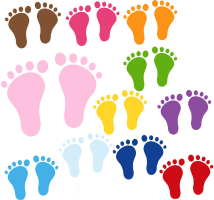Colors -- Toddler
Colors
Children began to notice the differences between colors at 18 months. Noticing differences and fully understanding the different colors and naming them takes longer. Typically a child is able to correctly identify at least one color at 3 years old.
Learning colors is an abstract concept that takes time and a lot of patience. Exposing children to colors will help with their development.
Hands On
Young children learn new concepts through play. They experience their world through their senses - touch, smell, and play. Flashcards will bore them and they will lose interest quickly. Think hands on games, art, puzzles.
One Color At A Time
Introduce one color at a time. Learning colors one by one is much easier. Spend a week or a month with each color
Label everything that month's (or week's) color. Everything that is that color label it. When children are coloring on paper and use that color - label it.
Pick up items by one color. If working on the color blue ask children to help pick up blocks and toys that are blue.
Add that color to art areas and art time crafts.
Find The Color
I see something blue.
(hold hand above eyes as if searching)
I see something blue.
I see something blue.
Find something blue!
Change the color word to what color you are introducing the children to.
Bluebird, Bluebird
Need: 1 bluebird necklace made from yarn and construction paper.
Bird Outline
The children stand in a circle and join hands. One child wears the bluebird necklace. The child who is the bluebird weaves in and out of the children's arms while the remainder of the children chant:
Bluebird, bluebird through my window
Bluebird, bluebird through my window
Bluebird, bluebird through my window
Who will be the next bluebird?
At this time the child takes off the necklace and hands it to a child he would like to be the next bluebird.
Use differnt color bird depending on the monthly color - yellow bird, red bird, blackbird....
Learning Centers
Colored Magnifier
Need: colored cellophane, file folders, glue
 On a folded file folder trace a magnify glass shape - that way you will cut out two magnify glass shapes. Keep the handle wide. Cut a circle out in the middle of the magnify shapes, keeping the border thick
On a folded file folder trace a magnify glass shape - that way you will cut out two magnify glass shapes. Keep the handle wide. Cut a circle out in the middle of the magnify shapes, keeping the border thick
Open magnify shapes. Cut out a square of colored cellophane and place glue dots around the circle you cut out, place cellophane over the circle area. Dots of glue on one of the magnify shapes and glue both magnify shapes together. Place on your science table. Children love holding this up and looking through it.
Art
Scissor Practice
Give children a light shade construction paper of the color for that month. For example, a square of light blue construction paper and scissors. After cutting up or tearing the light blue paper children can glue (use liquid starch) the pieces on dark blue construction paper. For young children give each child a small cup of liquid starch and a paint brush. The children paint the liquid starch on the paper and place the cut-up shapes on it.
Playdough
Make playdough that is the color for that week or month.
Matching
Distinction between colors is more clear to children if the objects are the same. For example, two balls of different colors.
Sock Ball Toss
Need: piles of rolled up socks or bean bags- two different colors, baskets, construction paper, tape
Tape a piece of construction paper, that matches the color of the socks, on each basket. Roll up socks into a ball shape. Give child a sock ball of any color and ask the child to throw it into the basket with the same color square that matches.
Hungry Monster Color Sorters
Two-daloo has a wonderful sorting activity for young children. Cut out the front panel on juice bottles. Cover scratchy edges with felt or colored duct tape.






